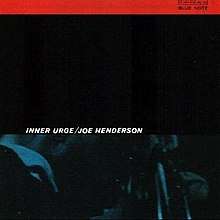Inner Urge (Joe Henderson album)
Inner Urge is an album by jazz saxophonist Joe Henderson released in 1966, the fourth recorded as a leader for Blue Note Records. It was recorded at the Van Gelder Studio, Englewood Cliffs, New Jersey on November 30, 1964. It features Henderson playing tenor sax, along with pianist McCoy Tyner and drummer Elvin Jones (both of whom were members of the John Coltrane quartet at the time of the recording). The album's bass player, Bob Cranshaw, was a regular member of Sonny Rollins' band at the time of the recording, and was also a frequent session musician for record labels including Blue Note, Prestige and Atlantic.[5][6]
| Inner Urge | ||||
|---|---|---|---|---|
 | ||||
| Studio album by | ||||
| Released | End of March/early April 1966[1] | |||
| Recorded | November 30, 1964 | |||
| Studio | Van Gelder Studio, Englewood Cliffs | |||
| Genre | Jazz, hard bop | |||
| Length | 43:14 | |||
| Label | Blue Note BST 84189 | |||
| Producer | Alfred Lion | |||
| Joe Henderson chronology | ||||
| ||||
| Review scores | |
|---|---|
| Source | Rating |
| Allmusic | |
| Penguin Guide to Jazz | |
| All About Jazz | (very favorable)[3] |
| The Rolling Stone Jazz Record Guide | |
The compositions
Jazz critic Nat Hentoff interviewed Henderson for the album's original liner notes essay, and Henderson described the creative impulses behind several of the songs to Hentoff. The title track, "Inner Urge," (which has since become a Jazz Standard), was a reflection of a time in his life when Henderson was "coping with the anger and frustration that can come of trying to find your way in the maze of New York, and of trying to adjust the pace you have to set in hacking your way in that city in order to just exist." Henderson also told Hentoff that "Isotope" is a tribute to Thelonious Monk and Monk's use of musical humor. Hentoff writes elsewhere in the liner notes that "El Barrio" represents Henderson's attachment to the "Spanish musical ethos", and that the piece was inspired by Henderson reflecting on his childhood in Lima, Ohio. Henderson is quoted as saying that he gave the other musicians "two simple chords, B minor and C major 7 (B phrygian)", and asked them "to play something with a Spanish feeling" while he improvised a melody for the piece.[7]
Reception
The Penguin Guide to Jazz gave the album a four-star rating (of a possible four stars), describing the music as "dark and intense".[8]
Track listing
All compositions by Joe Henderson, except where noted.
- "Inner Urge" – 11:58
- "Isotope" – 9:15
- "El Barrio" – 7:15
- "You Know I Care" (Duke Pearson) – 7:22
- "Night and Day" (Cole Porter) – 7:24
Personnel
Musicians
- Joe Henderson – tenor saxophone
- McCoy Tyner – piano
- Bob Cranshaw – bass
- Elvin Jones – drums
Personnel
- Alfred Lion – producer
- Francis Wolff – cover photograph
References
- Billboard Apr 9, 1966
- Gioffre, Daniel. "Inner Urge – Joe Henderson | AllMusic". allmusic.com. Retrieved 17 July 2011.
- Weinstein, Norman (2 July 2004). "Joe Henderson: Inner Urge". allaboutjazz.com. Retrieved 27 August 2013.
- Swenson, J., ed. (1985). The Rolling Stone Jazz Record Guide. USA: Random House/Rolling Stone. pp. 100. ISBN 0-394-72643-X.
- James Beaudreau. "Review at PopMatters". Retrieved 2007-07-29.
On November 30, 1964, nine days before John Coltrane would record A Love Supreme in the same room, late tenor saxophonist Joe Henderson brought two-thirds of Coltrane's rhythm section (and bassist Bob Cranshaw) into Rudy Van Gelder's New Jersey studio and recorded an under-recognized masterpiece.
- James Beaudreau. "Review at Allmusic". Retrieved 2007-07-29.
He is joined on Inner Urge by veterans of other combos: McCoy Tyner and Elvin Jones from John Coltrane's unit and Sonny Rollins sideman Bob Cranshaw
- Original liner notes by Nat Hentoff
- Cook, Richard; Brian Morton (2006) [1992]. The Penguin Guide to Jazz Recordings. The Penguin Guide to Jazz (8th ed.). New York: Penguin. p. 627. ISBN 0-14-102327-9.